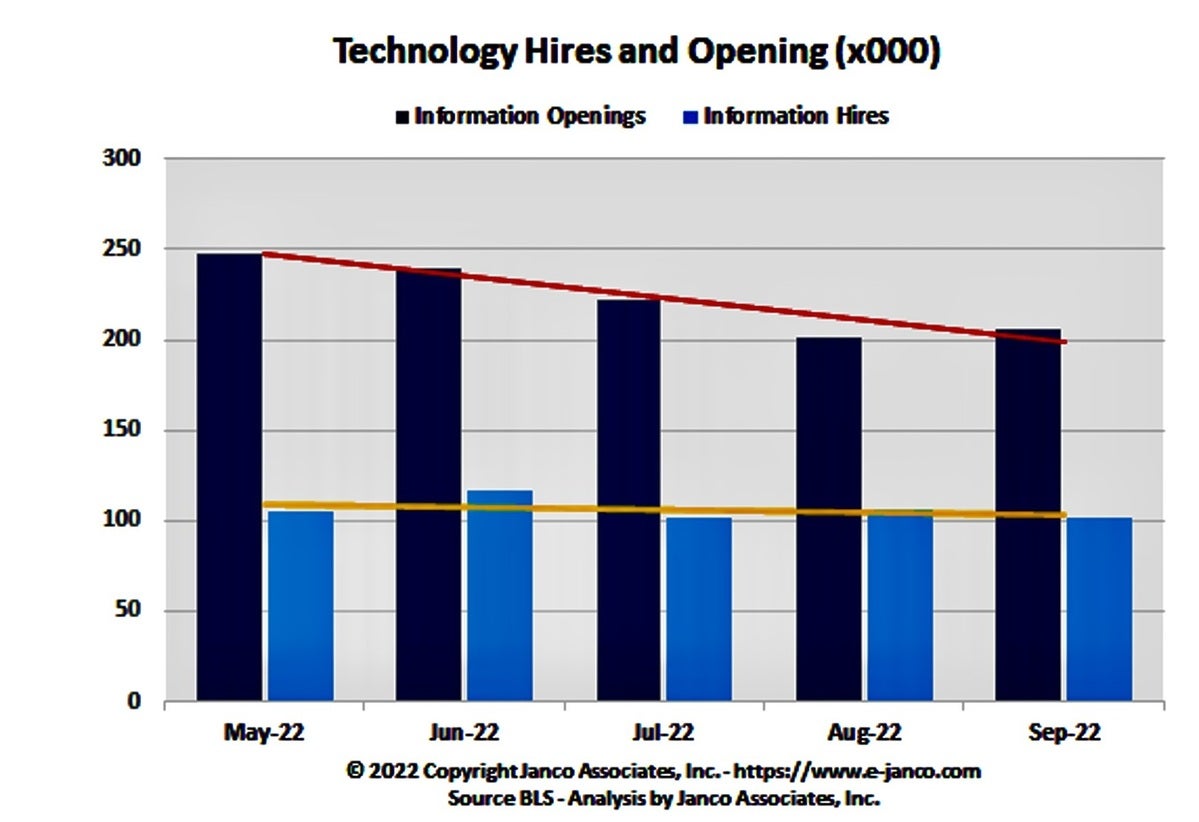
Despite high-profile layoffs in the technology sector continuing, demand for experienced IT professionals remains high, according to a new report from IT employment consultancy Janco Associates.
More than 100.000 jobs for experienced IT professionals remain unfilled in the United States, according to the Janco report. These roles include coders, application design specialists, security and compliance specialists, and blockchain/e-start engineers at all levels.
 Janco Associates
Janco AssociatesHowever, the Janco report notes, the total number of open positions for IT professionals has fallen in the past six months from more than 250.000 to 200.000.
At the same time, some 100.000 jobs are filled each month, of which between 12.000 and 14.000 are newly created positions, according to Janco. In the last 3 months, more than 37.000 new jobs have been created in this sector of the labor market.
 Janco Associates
Janco Associates"It's unclear at this point how many of the job cuts at major tech companies will be classified as lost jobs by the Janco report said. "However, even if they all are, there will still be a shortage of experienced IT professionals.
So how does Janco explain all these layoffs at tech companies?
"Low productivity" workers deemed useless
“Many 'IT professionals' abandoned by Twitter, Amazon, Facebook and other big tech companies were not experienced IT professionals. They were, for lack of a better description, administrative 'overload' or low-productivity workers,” Janco's report says. "Most will have a hard time finding work, just like the IT professionals who were laid off in the dotcom crash."
Jack Gold, founder and principal analyst at J. Gold Associates, disputed Janco's assessment, saying companies that lay off thousands of employees are unlikely to get rid of essentially unproductive workers.
"It's pretty hard for me to believe that 50% of the Twitter workforce was dead wood," Gold said. "Like all companies, there probably were, but I suspect they weren't even trying to cut those workers. When you have mass layoffs instead of just telling your managers to get rid of the hardworking inferior 5-10% employees, most likely is that you throw the good with the bad".
It's probably true that most of the laid-off workers weren't traditional IT employees like those typically found in a business, Gold said. Many were probably programmers with a specialty. Others may have specialized in certain aspects of running a business like Twitter, Facebook, Amazon, and others, so they may need retraining to fit into a traditional IT role.
"But that doesn't mean they're unqualified. Chances are, with a little training, they'll be fine," Gold said, referring to their future job prospects.
Layoffs will continue in the tech industry
The goal for many IT organizations looking toward a potential downturn will be to eliminate management levels and increase the span of control for supervisors and managers while engineering and coding positions expand, Janco said. This assessment matches that of Tony Lysak, CEO of The Software Institute.
Over the past two years, the tech talent shortage due to ongoing digitization efforts and the Great Resignation have seen companies scrambling to hire as many experienced tech workers as possible. But these workers typically had expertise in a specific technology, leaving organizations overburdened with mid-level workers, compared with less-experienced employees who can be honed over time to create a more sustainable workforce.
"This is how you get this very inflated middle: 60% to 80% of your tech workforce are highly paid engineers..., instead of having a balance where 30% to 40% of workers have this experience of zero to two years, Lysak said.
Due to this inflation, the layoffs are expected to continue until 2023.
Digital services company West Monroe recently surveyed about 500 US-based executives and top executives about their forecasts for the coming year. About four in 10 respondents (41%) across various industries said they were laying off, had already laid off, or plan to lay off in the next six months.
The investigation also revealed that:
- More than 50% of tech industry respondents said they were considering layoffs or had made layoffs.
- 64% of those surveyed said employee morale was the biggest challenge when considering layoffs.
- Nearly 60% of the tech companies surveyed said that meeting sales and growth targets is the biggest challenge their company will face in the coming year.
Experienced IT professionals always sought after
Despite the layoffs continuing, unemployment in the tech sector has remained at near record lows, hovering at 2,2%. This compares with the general unemployment rate of 3,7% in the United States in October.
So far this year, employment in the technology industry has increased by 193.900 jobs, up 28% from the same period in 2021, according to an employment report from CompTIA, a nonprofit organization for IT industry and workforce.
"Hiring activity in the technology sector is holding steady, but there are undoubtedly concerns about the slowing economy," CompTIA Chief Executive Tim Herbert said in a statement.
While the November jobs data is not expected to be as strong as the same period last year (when 73,600 jobs were added), the overall projection is that it will remain at the status quo level, with hiring continuing at the same pace than in the last two quarters.
"In general, experienced IT professionals will be in high demand," Janco said. “Especially those who demonstrate a strong work ethic and are results-oriented. The positions that will have little demand will be those of supervisors and administrative managers and not line. »
Gold agreed, noting that the current shortage of tech workers, despite layoffs at major companies, will ensure that most, if not all, are rehired.
"Now if the layoffs continue and/or we go into a recession, then all bets are off." "At this point, it's not so much a skills issue as a massive oversupply of workers."
Copyright © 2022 IDG Communications, Inc.